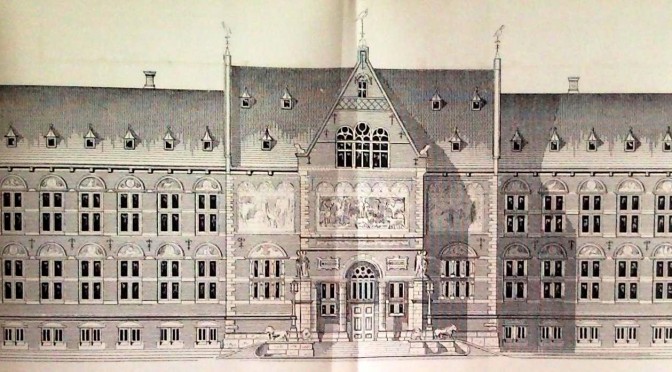By Robert-Jan Wille
In the 1870s, after the Franco-Prussian war, the art and sciences budget of the Netherlands increased dramatically. If the Dutch ever had an Victorian age in which some dreamt of cathedrals of science, it was then. In 1872-3 nearly 1,5 million guilders (quite a lot at that time) was reserved to upgrade Leiden University and the State Museum of Natural History. The university would get a new zoological laboratory and a new main building (academiegebouw); the state museum would be able to move to a bigger building as well.First, a new building was envisioned for all three of them. Putting the museum and the university laboratory in one building was a major breakthrough but also something to be expected. At this time, the relation between the state museum and the university zoologists was better than it had ever been before. Both were led by German friends of the late Wilhelm Moritz Keferstein (1833-1870). The state museum’s director was Hermann Schlegel (1804-1884); the chair in zoology at the university was Emil Selenka (1842-1902).
But a new zoological laboratory was soon built somewhere else; Selenka had been asking for it since 1868 and when the money was finally allocated he didn’t want to wait for the others. He had grown impatient with the civil servants of the Dutch state, and maybe foreseen some things.
In the meantime, civil servants decided that it would not be wise either to join the academiegebouw with the new museum, and so they decided to build two new buildings and, well, why not put two committees on it?
A team was sent out to study museums of natural history in other large cities, like Berlin, Paris and London. This team consisted of three members. The first was J. B. A. J. M. Verheyen, a roman catholic and conservative member of parliament. The second was the famous architect Pierre Cuypers, who had developed many churches, had developed the new Rijksmuseum, and was to develop the new Amsterdam central train station. The third member was one of the curators of the museum, the liberal evolutionary biologist Ambrosius Hubrecht, who also happened to be the son of the secretary-general of the ministry of the Interior. They wrote a report on these foreign musea and based on these visits they came up with a design for the new museum.
They created this:
 In my dissertation on late nineteenth century Dutch biologists and the imperial state I will look into the matter with a bit more detail. What I can tell you at the moment is that it was not built in the end. (Well, that is a fact easily induced from the absence of such a building in Leiden.)
In my dissertation on late nineteenth century Dutch biologists and the imperial state I will look into the matter with a bit more detail. What I can tell you at the moment is that it was not built in the end. (Well, that is a fact easily induced from the absence of such a building in Leiden.)
The director of the museum, Schlegel, came with a competing design himself; Hubrecht would leave the museum to pursue a career at the university of Utrecht as professor in zoology; Cuyper would work on other projects. In the 1880s, the allocated money was silently taken away from the national budget. Why?
Was it because Dutch and national museums never were and never will be a winning team?
o-o-o
Robert-Jan Wille is an expert in late nineteenth of laboratory biology in the field, both zoology and botany. He likes tree-like ferns, tarsiers, herring and onions, and loves watching nature, especially from behind the window.

